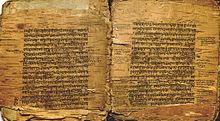- Moksopaya
-
Birch bark manuscript S14 of the Utpattiprakaraṇa Mokṣopāya (circa 16th-17th century AD).

The Mokṣopāya or Mokṣopāyaśāstra is a Sanskrit philosophical text on salvation for non-ascetics (mokṣa-upāya: 'means to release'), written on the Pradyumna hill in Śrīnagar in the 10th century AD.[1][2] It has the form of a public sermon and claims human authorship and contains about 30,000 śloka's (making it longer than the Rāmāyaṇa). The main part of the text forms a dialogue between Vasiṣṭha and Rāma, interchanged with numerous short stories and anecdotes to illustrate the content.[3][4] This text was later (11th to the 14th century AD)[5] expanded and vedanticized, which resulted in the Yogavāsiṣṭha.[6]
Contents
Philosophy
The text of the Mokṣopāya shows that a unique philosophy has been created by the author. It taught a monism ('advaita') that is different from Advaita Vedanta. It makes use of other Darśanas in an inclusive way. The text teaches that the recognition that cognitive objects are non-existent, leads to ultimate detachment, which causes an attitude of "dispassion and non-involvement with worldly things and matters", though still fulfilling one's daily duties and activities.[4] This liberation is available for everyone, no matter their sex, caste or education, as long as one uses reason and maintains an active life in this world. To reach this liberation, one has to go through three stages: rational thinking (vicāra), true understanding (jñāna) and detachment (vairāgya).[7]
It is only by one's own effort (pauruṣa) that one can be liberated from the bonds of existence. For one, who knows the reality, "fate" (daiva) does not mean anything, something like "fate" does not exist and has, accordingly, no consequences at all.[8][9]
Mokṣopāya Project
The Mokṣopāya Project supervised by professor Walter Slaje at the Martin Luther University of Halle-Wittenberg in Germany is currently working on a critical edition of the Mokṣopāya.[10] The project is embedded in the Centre for Research in the Historiography and Intellectual Culture of Kashmir (under the Patronage of the Academy of Sciences and Literature, Mainz). A commentary by Bhāskarakaṇṭha ("Mokṣopāya-ṭīkā"; late 17th century AD)[11] and more than thirty manuscripts in Nāgarī, Śāradā, Grantha, and Telugu scripts are being used.[12][13] [14]
The critical edition of the complete Sanskrit text is expected to be finalized by the end of 2018. It will be accompanied by a German translation, a philological commentary and a dictionary of its Sanskrit vocabulary (all in German).
See also
- Buddhism and Hinduism in Kashmir
- Yogavāsiṣṭha
References
- ^ Slaje, Walter. (2005). "Locating the Mokṣopāya", in: Hanneder, Jürgen (Ed.). The Mokṣopāya, Yogavāsiṣṭha and Related Texts Aachen: Shaker Verlag. (Indologica Halensis. Geisteskultur Indiens. 7). p. 35.
- ^ Gallery - The journey to the Pradyumnaśikhara
- ^ Leslie 2003, pp. 104–107
- ^ a b Lekh Raj Manjdadria. (2002?) The State of Research to date on the Yogavasistha (Moksopaya).
- ^ Hanneder, Jürgen; Slaje, Walter. Mokṣopāya Project: Introduction.
- ^ Chapple 1984, pp. x-xi
- ^ Leslie 2003, pp. 106
- ^ Hanneder 2006, pp. xi, 199–203
- ^ Slaje, Walter (2000). "Wie man sein Schicksal (daiva) meistert. Der Mokṣopāya über Wesen und Wirksamkeit menschlicher Aktivität (pauruṣa)", in: Asiatische Studien 54, pp. 63-101.
- ^ Jürgen Hanneder. (2000). Notes on the Quality of the Text.
- ^ Sanderson, Alexis (2007): "The Śaiva Exegesis of Kashmir", in: Mélanges tantriques à la mémoire d’Hélène Brunner: Tantric studies in memory of Hélène Brunner. edited by Dominic Goodall & André Padoux (Collection Indologie; 106) Pondicherry: Inst. Français de Pondichéry, pp. 231-442 (p. 422).
- ^ Olivelle, Patrick. Bhaskarakanthas Moksopaya-Tika: Die Fragmente des 3. Prakarana. Journal of the American Oriental Society. Jan-March 1997.
- ^ Mokṣopāya Project: The Sources
- ^ Some examples at: Mokṣopāya Project: Gallery of Moksopāya-Manuscripts.
- Chapple, Christopher; translation: Venkatesananda, Swami (1984). "Introduction". The Concise Yoga Vāsiṣṭha. Albany: State University of New York Press. ISBN 0873959558. OCLC 11044869. http://books.google.com/books?id=1FFdOj2dv8cC.
- Hanneder, Jürgen (2006). Studies on the Mokṣopāya. Otto Harrassowitz Verlag. ISBN 3447054220. http://books.google.com/books?id=eluUcFH5tBAC.
- Leslie, Julia (2003). Authority and meaning in Indian religions: Hinduism and the case of Vālmīki. Ashgate Publishing, Ltd.. ISBN 0754634310. http://books.google.com/books?id=466QEN_Av4MC.
External links
- Website of the Mokṣopāya Project
- Moksopaya with Bhaskarakantha's Tika, Prakaranas 1-4 (with notes). (transliterated Sanskrit; uncorrected preprint of the edition published by W. Slaje in 1996)
Categories:- Monism
- Sanskrit texts
Wikimedia Foundation. 2010.


